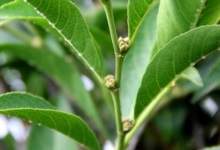

A ‘nickel eating’ plant has been discovered in the Philippines that could offer the mining sector a new and more environmentally friendly way of extracting the metal, provided the industry doesn’t bring about its extinction first.
Discovered by a team of researchers from the University of the Philippines working on Luzon Island, the new species Rinoreaniccolifera has been found to soak up significant amounts of nickel that could be extracted for commercial use.
In a paper detailing the characteristics and appearance of the forest shrub, the researchers explained that it is capable of collecting levels of up to 18,000 parts per million of nickel in its leaf tissues by absorbing it from the metal-rich soil surrounding it, qualifying it as nickel-hyperaccumulator.
A rare find
Referring to this aspect of the plant, the researchers from the Universities Department of Forest Biological Sciences wrote: "The ability to absorb certain metals and metalloids from the soil and to accumulate them in shoot tissues in exceptionally high and normally toxic concentrations without any evidence of physiological stress is rather rare among plants." The find follows earlier discoveries of plants that hyperaccumulate nickel in Western Australia and Sri Lanka.
The researchers explained that the plant could offer exciting opportunities for the metals mining industry by using it to either clean up toxic metals that are left over from mining activities or alternatively by being employed to extract the nickel in the first place, with the metal then being extracted from the leaves. Dr Augustine Doronila of the School of Chemistry, University of Melbourne,who co-authored the paper, said: "Hyperacccumulator plants have great potentials for the development of green technologies, for example, ‘phytoremediation’ and ‘phytomining’."
The Internet of Things, robotics and plasma are transforming mining into a safer and more productive industry.

US Tariffs are shifting - will you react or anticipate?
Don’t let policy changes catch you off guard. Stay proactive with real-time data and expert analysis.
By GlobalDataIn an ironic twist of fate, the industry for which the plant holds the greatest potential for commercial application is also one of its biggest threats. Under IUCN Categories and Criteria on conservation status, it is classed endangered. The threat of extinction is partly down to the fact that it is only known to grow in a small area and that its existing habitat is subject to open pit mining.
Is it feasible?
Research into the commercial value of hyperaccumulator plants has been ongoing for a number of decades. Back in 1975, a team led by Alan Baker, head of botany at the University of Melbourne, discovered a plant called spring sandwort growing in iron-rich grounds in the Peak District that, like the species discovered in the Philippines, is capable of absorbing high levels of metals normally classed as toxic.
Commenting on the potential environmental benefits of using such species of plants to extract potentially toxic and damaging elements from mining sites and other areas, Baker said: "It is environmentally friendly as it can be applied in situ to large areas and does not alter the biological, chemical, and physical properties of the substrate, thus allowing for ecological restoration of contaminated sites and thus alternative land uses."
In a previous experiment to demonstrate how the plants could be used, Baker and his team converted 500mg of plant ash into 100mg of nickel by burning it in a furnace. Further research into commercial exploitation of the plants has slowed significantly in recent years after the company that sponsored much of the research and owns vital patents pulled the plug on further work.
In a 2009 paper titled’Indicative assessment of the feasibility of Ni and Au Phytomining in Australia’, researchers predicted that a hectare of the plant Brassica Juncea would return a profit of approximately A$26,000 when coupled with the energy generation value of the biomass.
The two main issues dictating the economic viability of phytomining are the level of concentration level of metal in the specific plant and the market price of the metal. As a result, hyperaccumulators of gold are judged as the most promising, due to the high price for gold.
With greater pressure on mining companies to operate in an environmentally sustainable manner, the value of using hyperaccumulators to extract metals from already mined sites moves the proposition beyond simply economic factors.
While the latest discovery and previous work in the area are yet to prove a sustainable and scalable method of capitalising on the characteristics of metal eating plants, a position of increased optimism is justified. The patents that promised so much before transforming into barriers to development are soon to expire, enabling researchers in the area access to vital information. Further, the commercial environment has changed significantly since research was shut down.
The mining industry, while still receiving heavy criticism for its environmental record, is exploring environmental applications more than ever, and the plants constitute an attractive area to explore.


.gif)

